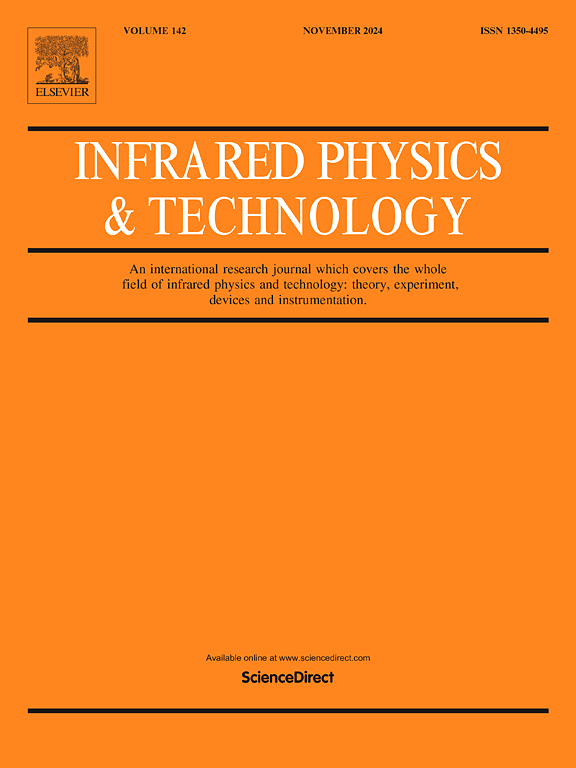Wavelet transform based post processing approach for pulse compression favourable frequency modulated thermal wave imaging for non-destructive testing and evaluation
IF 3.1
3区 物理与天体物理
Q2 INSTRUMENTS & INSTRUMENTATION
引用次数: 0
Abstract
InfraRed Thermography (IRT) for Non-Destructive Testing and Evaluation (NDT&E) is used across various industries to inspect components and structures to detect and identify the hidden defects in them. Since Thermal NDT&E (TNDT&E) captures the surface conditions remotely within a reasonable time, several inspection and predictive maintenance programs have employed challenging traditional computer vision algorithms to detect surface and subsurface defects in various materials. In this work, a Glass Fibre Reinforced Polymer (GFRP) sample having artificially simulated flat-bottom holes at various depths was examined with the Frequency Modulated Thermal Wave Imaging (FMTWI) technique. The thermal data acquired using FMTWI for the sample contains various environmental and experimentally generated noises. Principal Component Thermography (PCT) using Singular Value Decomposition (SVD) has been carried out to qualitatively enhance the spatial thermal contrast that simultaneously provides temporal thermal profiles with reduced dynamic range. Pulse Compression on the obtained PCT sequence using the cross-correlation approach improves the range resolution of the subsurface defects. Wavelet transforms like Haar, Mexican Hat, and Morlet are applied to the frames within the half-width region of the main lobe in pulse-compressed signal to study their effect on defect detection capabilities and visualize the Region of Interest (RoI), specifically the circular defect region within the material. The novel thermal pattern enhancement method extends IRT-based Automated Defect Recognition (ADR) for more precise defect-detection and localization particularly for GFRP structures, which are mostly used in aerospace and shipbuilding industries.
基于小波变换的脉冲压缩有利频率调制热波成像后处理方法,用于无损检测和评估
红外热像仪(IRT)用于无损检测和评估(ndt &;E)在各个行业中用于检查组件和结构,以检测和识别其中隐藏的缺陷。由于Thermal NDT&;E (TNDT&;E)可以在合理的时间内远程捕获表面状况,因此一些检查和预测性维护计划采用了具有挑战性的传统计算机视觉算法来检测各种材料的表面和地下缺陷。在这项工作中,使用调频热波成像(FMTWI)技术检查了在不同深度人工模拟平底孔的玻璃纤维增强聚合物(GFRP)样品。利用FMTWI获取的样品热数据包含各种环境和实验产生的噪声。采用奇异值分解(SVD)的主成分热成像技术(PCT)定性地增强了空间热对比,同时提供了动态范围减小的时间热剖面。利用互相关方法对得到的PCT序列进行脉冲压缩,提高了亚表面缺陷的距离分辨率。将Haar、Mexican Hat和Morlet等小波变换应用于脉冲压缩信号中主瓣半宽区域内的帧,研究它们对缺陷检测能力的影响,并可视化感兴趣区域(RoI),特别是材料内的圆形缺陷区域。这种新型的热模式增强方法扩展了基于红外光谱的自动缺陷识别(ADR)技术,用于更精确的缺陷检测和定位,特别是用于航空航天和造船工业的玻璃钢结构。
本文章由计算机程序翻译,如有差异,请以英文原文为准。
求助全文
约1分钟内获得全文
求助全文
来源期刊
CiteScore
5.70
自引率
12.10%
发文量
400
审稿时长
67 days
期刊介绍:
The Journal covers the entire field of infrared physics and technology: theory, experiment, application, devices and instrumentation. Infrared'' is defined as covering the near, mid and far infrared (terahertz) regions from 0.75um (750nm) to 1mm (300GHz.) Submissions in the 300GHz to 100GHz region may be accepted at the editors discretion if their content is relevant to shorter wavelengths. Submissions must be primarily concerned with and directly relevant to this spectral region.
Its core topics can be summarized as the generation, propagation and detection, of infrared radiation; the associated optics, materials and devices; and its use in all fields of science, industry, engineering and medicine.
Infrared techniques occur in many different fields, notably spectroscopy and interferometry; material characterization and processing; atmospheric physics, astronomy and space research. Scientific aspects include lasers, quantum optics, quantum electronics, image processing and semiconductor physics. Some important applications are medical diagnostics and treatment, industrial inspection and environmental monitoring.

 求助内容:
求助内容: 应助结果提醒方式:
应助结果提醒方式:


